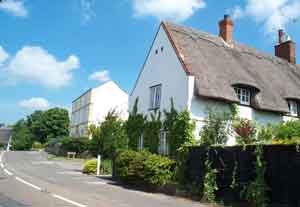

In the 1930s and 40s, Lower Way, as Main Street, had more tradespeople than today.The first block was a garage from which lorries ran, Mr Curtis (who lived in Ivy House) had an electrical shop here.
Dairy Cottage are private houses now
Also in Lower Way is the old Police House (no. 37). This is built of local sandstone, and, before it was extended, it hod a thatched roof, which rather appropriately looked like a Policemans helmet! Mrs Mobbs lived in this house in the 1930s and could often be seen sitting outside her front door making lace. She was one of the last lacemakers in the village, but the area was known in the past for its lacemaking.
Opposite the old Duncombe Arms is the point in the village where you can get a magnificent view across Aylesbury Vale towards Mursley. Looking over the wall here, you are looking into the field where one of Great Brickhill's two visiting fairs set up its attractions. This was the Michelmas fair and was much looked forward to, the fair stayed in the village for three days each year.
Next to the Duncombe Arms there was a dairy, but only the cottages remain. You will also find the Blacksmith's forge in Lower Way. Unlike most villages, there is still a working forge in Great Brickhill. These days, many horses are not local to the village, but come long distances to use the Blacksmiths services.
The village Post Office until after the Second War was situated opposite the Church at the far end of Lower Way.
The walled area of Lower Way along from the church was the kitchen garden for the Manor. and had up to four gardeners working on it. Some of the produce was sold to the villagers, and they even had a Peach House! Next to the kitchen garden was a timber yard which today is on the property known as Chartwell Moor.


